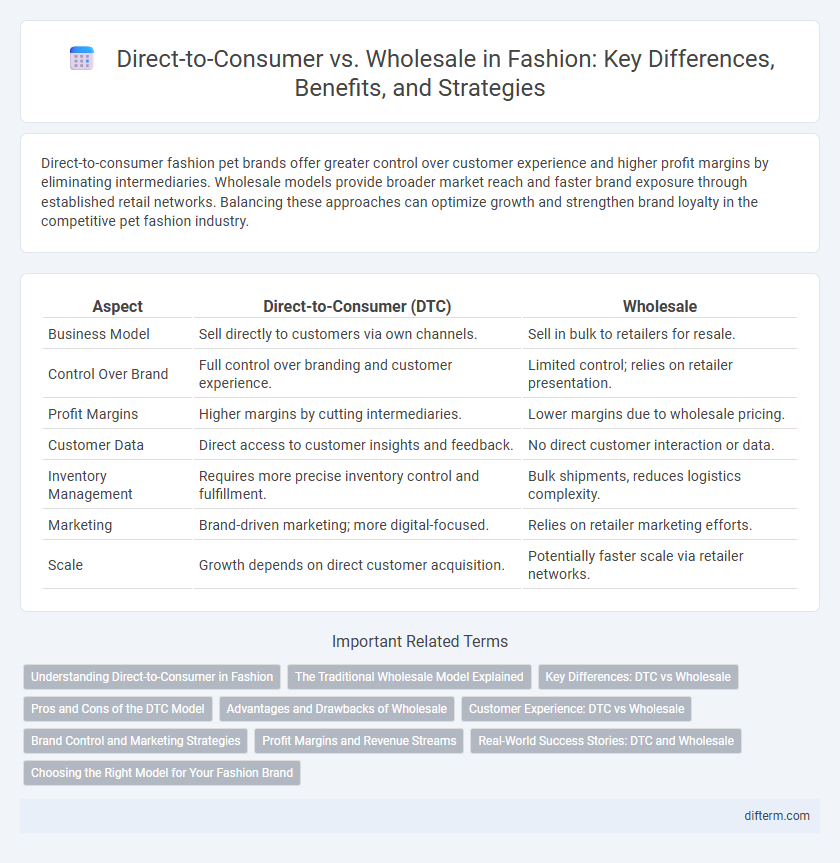Direct-to-consumer fashion pet brands offer greater control over customer experience and higher profit margins by eliminating intermediaries. Wholesale models provide broader market reach and faster brand exposure through established retail networks. Balancing these approaches can optimize growth and strengthen brand loyalty in the competitive pet fashion industry.
Table of Comparison
| Aspect | Direct-to-Consumer (DTC) | Wholesale |
|---|---|---|
| Business Model | Sell directly to customers via own channels. | Sell in bulk to retailers for resale. |
| Control Over Brand | Full control over branding and customer experience. | Limited control; relies on retailer presentation. |
| Profit Margins | Higher margins by cutting intermediaries. | Lower margins due to wholesale pricing. |
| Customer Data | Direct access to customer insights and feedback. | No direct customer interaction or data. |
| Inventory Management | Requires more precise inventory control and fulfillment. | Bulk shipments, reduces logistics complexity. |
| Marketing | Brand-driven marketing; more digital-focused. | Relies on retailer marketing efforts. |
| Scale | Growth depends on direct customer acquisition. | Potentially faster scale via retailer networks. |
Understanding Direct-to-Consumer in Fashion
Direct-to-consumer (DTC) in fashion allows brands to sell products directly to customers, bypassing traditional retail channels and reducing reliance on wholesalers. This model enhances customer engagement, provides valuable consumer insights, and enables faster response to market trends by controlling the entire buying experience. DTC brands benefit from higher profit margins and stronger brand loyalty due to personalized marketing and direct feedback loops.
The Traditional Wholesale Model Explained
The traditional wholesale model involves brands selling products in bulk to retailers, who then handle pricing, marketing, and distribution to consumers. This approach often requires significant upfront production costs and limits the brand's control over customer experience and data. Despite these challenges, wholesale remains a crucial channel for expanding market reach and building brand presence in physical stores.
Key Differences: DTC vs Wholesale
Direct-to-consumer (DTC) brands maintain full control over pricing, branding, and customer experience by selling products directly through online platforms, bypassing traditional retail intermediaries. Wholesale involves selling bulk inventory to retailers who then manage sales and customer interactions, enabling wider market reach but with less control over brand presentation. DTC models typically yield higher profit margins per unit, while wholesale strategies benefit from larger sales volume and broader distribution channels.
Pros and Cons of the DTC Model
The direct-to-consumer (DTC) model allows fashion brands to control their branding and customer data while enjoying higher profit margins by eliminating intermediaries. However, it requires substantial investment in marketing, customer acquisition, and logistics, posing challenges for scalability and operational efficiency. Unlike wholesale, which offers broader market exposure and reduced distribution costs, DTC demands continuous engagement to build brand loyalty and maintain inventory management.
Advantages and Drawbacks of Wholesale
Wholesale enables fashion brands to rapidly scale by leveraging established retailer networks, increasing market reach and brand visibility. However, it often results in lower profit margins due to bulk pricing and relinquished control over brand presentation and customer experience. Dependence on retail partners can also create vulnerability to fluctuating orders and inventory challenges.
Customer Experience: DTC vs Wholesale
Direct-to-consumer (DTC) brands deliver a personalized customer experience through tailored marketing, direct feedback channels, and customized product offerings, enhancing brand loyalty and satisfaction. Wholesale models rely on third-party retailers, which can dilute the brand message and limit customer engagement due to less control over the purchasing environment. DTC's ability to collect real-time consumer data enables rapid adaptation to trends and improved service, creating a more seamless and immersive shopping journey compared to wholesale distribution.
Brand Control and Marketing Strategies
Direct-to-consumer (DTC) brands maintain greater control over their brand identity and customer experience by managing all marketing strategies internally, enabling tailored content and personalized engagement. Wholesale distribution often dilutes brand messaging due to reliance on third-party retailers and shared marketing channels, reducing direct interaction with end consumers. DTC models leverage data analytics and targeted advertising to optimize brand positioning, while wholesale focuses on broad market reach through established retail networks.
Profit Margins and Revenue Streams
Direct-to-consumer (DTC) fashion brands typically experience higher profit margins by eliminating intermediaries and retaining full retail pricing power, while wholesale models often yield lower margins but enable larger volume sales and broader market access. DTC revenue streams benefit from personalized customer data, fostering targeted marketing and customer loyalty, whereas wholesale relies on bulk orders from retailers, leading to unpredictable demand and reduced brand control. Maximizing profitability in fashion requires balancing the steady revenue of wholesale with the high-margin, data-driven growth potential of direct-to-consumer channels.
Real-World Success Stories: DTC and Wholesale
Direct-to-consumer (DTC) brands like Everlane have leveraged personalized marketing and transparent pricing to build strong customer loyalty and rapid growth. In contrast, wholesale giants such as Nike maintain extensive retail partnerships, enabling broad market reach and substantial revenue via physical stores. Real-world success shows that combining DTC's direct customer engagement with wholesale's vast distribution network can optimize brand visibility and profitability in the fashion industry.
Choosing the Right Model for Your Fashion Brand
Choosing the right business model for your fashion brand involves evaluating direct-to-consumer (DTC) and wholesale strategies based on target audience reach and profit margins. DTC offers higher control over branding and customer data, enabling personalized marketing and faster feedback, while wholesale provides rapid market penetration and bulk sales through established retailers. Balancing inventory management, cash flow, and brand positioning helps determine whether a DTC focus, wholesale distribution, or a hybrid approach maximizes growth potential and sustainability.
direct-to-consumer vs wholesale Infographic

 difterm.com
difterm.com